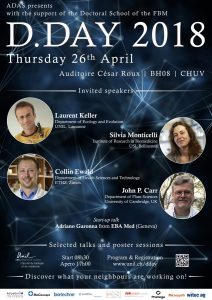Keynote speakers
Silvia Monticelli – Institute for Research in Biomedicine, USI, Bellinzona
“Regulation of T lymphocyte activation and functions”
Despite the central role of T lymphocytes in protecting our organism from invading pathogens, their activity must be carefully regulated to avoid excessive tissue damage, altered inflammatory responses or even oncogenic transformation. At a molecular level, T cell proliferation and functions are therefore regulated by a complex network of transcriptional and post-transcriptional mechanisms that integrate extracellular cues to finally provide responses appropriately tailored against each invading pathogen or noxious agent. Such regulatory mechanisms include transcription factors, epigenetic modifications, signaling molecules and also microRNAs. I will discuss our recent findings on how these mechanisms influence activation, acquisition of effector functions and pro-inflammatory potential of primary human T lymphocytes.
John P. Carr – Department of Plant Sciences, University of Cambridge, UK
“The sneaky world of virus-plant-insect interactions“
Do the alterations in plant defensive signaling and metabolism that occur in susceptible hosts following virus infection serve any purpose beyond directly aiding viruses to replicate and spread? Or indeed, are these host phenotype modifications purely incidental consequences of virus infection? A growing body of data, in particular from studies of viruses vectored by insects, suggests that viruses influence the efficiency of their own transmission by insect vectors. Furthermore, it appears that viruses may be able to provide rewards to susceptible host plants. This may be conditional, for example by aiding host survival under conditions of drought or cold or, more surprisingly, by helping plants attract beneficial insects such as pollinators. The talk will cover some of the work in my lab on these topics.
Collin Ewald – Department of Health Sciences and Technology , ETH, Zürich
“Prolonged Extracellular Matrix Homeostasis is Essential for Healthy Aging”
By 2030 almost every fourth person will be 65 or older in Switzerland, Europe, and USA. Since old age is the main risk factor for developing cancer, neurodegenerative, cardiovascular, and metabolic diseases, as well as other age-related pathologies, the growing elderly population poses an immense social and financial challenge. However, the onset of these diseases varies because the rate of aging is plastic and is influenced by environmental and genetic factors. For instance, people who live beyond 100 years (centenarians) spend most of their lives in good health. Importantly, centenarians carry polymorphisms in genes that have been discovered in model organisms, such as the nematode Caenorhabditis elegans, to extend lifespan. To understand the causal relationships between these gene alterations found in centenarians and healthy aging, C. elegans is indeed a pioneering system to model the aging process because of its ease for genetic manipulation, high evolutionary conservation of genes implicated in human diseases, and short lifespan (3 weeks).
By comparing previously published expression profiles of long-live mice and C. elegans, we discovered that almost all longevity-promoting interventions enhance extracellular matrix (ECM) gene expression and we found some tantalizing evidence of ECM expression or SNP in ECM receptors in published profiles of centenarians. Furthermore, we demonstrated that enhancing ECM gene expression is essential and sufficient for delaying aging of C. elegans. The importance of ECM production in diverse anti-aging interventions implies that extracellular matrix remodelling is a generally essential signature of longevity assurance, and that agents promoting extracellular matrix youthfulness may have systemic benefit.
References
Ewald, C.Y. et al., 2015. Dauer-independent insulin/IGF-1-signalling implicates collagen remodelling in longevity. Nature, 519(7541), pp.97–101.
Adriano Garonna from EBA-Med – External Beam Ablation Medical Devices, Geneva
“Ion Beam Therapy: cancers and beyond…”
Ion beam therapy is a particular type of external beam radiotherapy, which is experiencing an impressive growth throughout the world. We will review the biophysical rationale behind the use of ion beams for tumour treatment, along with the technology associated with this treatment modality.
Recent studies have opened the way for a new and promising additional use of ion beams in the field of cardiology. Based on these foundations, EBA-Med is a new start-up in Geneva that develops and commercializes a medical device to enable non-invasive treatments of cardiac arrhythmias using ion beams, as opposed to today’s surgical treatments via catheters.
Laurent Keller – Department of Ecology and Evolution, UNIL, Lausanne
Selected student short talks
- A. Mennella – Department of Dermatology, UNIL.
“Yin Yang of TNF and IFN alpha – A Role for B cells” - M. Serulla – Department of Physiology, UNIL.
“Mechanism of cell death induced by the TAT-RasGAP317-326 anticancer peptide” - B. Salomé – Department of Fundamental Oncology, CHUV/UNIL.
“ILC-killer: a distinct human ILC subset with KIR-independent cytotoxicity” - P. Gibson – Department of Fundamental Microbiology, UNIL.
“Epigenetically inherited antibiotic resistance: Another component of a multi-faceted problem” - D. Synefiaridou – Department of Fundamental Microbiology, UNIL.
“Harnessing the CRISPR system for genome editing in human pathogen S. pneumoniae“ - J. Lavier – ISSUL, UNIL.
“Effects of low intensity continuous exercise training, maximal intensity interval training and supra-maximal intensity repeated sprint training on endothelial function in healthy mice: a preliminary study.”
Committee 2018
Liliane Broye
Patricia Waszyk
Aurélie Scherler
Cassandre Kinnaer
Florian Tagini
Eleni Batzianouli
Aurélie M. Stephan
Eric Delarze
Lauriane Hamard
Olivier Bignucolo
Marion Aruanno
Pierre-Arnaud Aeberhard
